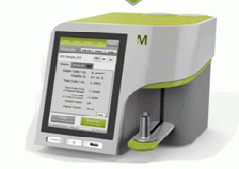The Muse™ PI3K Activation Dual Detection Kit includes two directly conjugated antibodies, a phospho-specific anti-phospho-Akt (Ser473), Alexa Fluor®555 and an anti-Akt, PECy5 conjugated
antibody to measure total levels of Akt. This two color kit is designed to measure the extent of Akt phosphorylation relative to the total Akt expression in any given cell population. By doing such, the levels of both the total and phosphorylated protein can be measured simultaneously in the same cell, resulting in a normalized and accurate measurement of PI3K activation after stimulation. Moreover, simultaneous measurement of both total and phospho-Akt confirms target specificity of the phosphorylation event. Together, a total and phospho antibody duo performed in multiplex provides an enhanced and more reliable detection of the phospho: total ratio within a mixed population.The kit is supplied with fix and perm reagents, cells are incubated 5 min each for fix and perm of cell membranes. The antibodies are supplied as a cocktail with 10ml being incubated with 200,000 cells in 200ml of Assay Buffer. After washing samples are acquired on the Muse, see figure.
The Muse™ MAPK Activation Dual Detection Kit includes two directly conjugated antibodies, a phospho-specific anti-phospho-ERK1/2 (Thr202/Tyr204, Thr185/Tyr187)-Phycoerythrin and an anti-ERK1/2-PECy5 conjugated antibody to measure total levels of ERK. This two color kit is designed to measure the extent of MAPK phosphorylation relative to the total MAPK expression in
any given cell population. By doing such, the levels of both the total and phosphorylated protein can be measured simultaneously in the same cell, resulting in a normalized and accurate measurement of MAPK activation after stimulation. Moreover, simultaneous measurement of both total and phospho-
ERK1/2 confirms target specificity of the phosphorylation event. Together, a total and phospho antibody duo performed in multiplex provides an enhanced and more reliable detection of the phospho: total ratio within a mixed population.The kit is supplied with fix and perm reagents, cells are incubated 5 min each for fix and perm of cell membranes. The antibodies are supplied as a cocktail with 10ml being incubated with 200,000 cells in 200ml of Assay Buffer. After washing samples are acquired on the Muse, see figure.
The Muse™ EGFR-RTK Activation Dual Detection Kit includes two directly conjugated antibodies, a phospho-specific anti-phospho-EGFR (Tyr1173)-Alexa Fluor®555 and an anti-EGFR-PECy5 conjugated antibody to measure total levels of EGFR expression. This two color kit is designed to detect the extent of EGFR pathway activation by measuring EGFR phosphorylation relative to the 2 total EGFR expression in any given cell population. By doing such, the levels of both the total and phos- phorylated protein can be measured simultaneously in the same cell, resulting in a normalized and accurate measurement of EGFR activation after stimulation. Moreover, simultaneous measurement of both total and phospho-EGFR confirms target specificity of the phosphorylation event. Together, a total and phospho antibody duo performed in multiplex provides an enhanced andmore reliable detection of the phospho: total ratio within a mixed cell population. The kit is supplied with fix and perm reagents, cells are incubated 5 min each for fix and perm of cell membranes. The antibodies are supplied as a cocktail with 10ml being incubated with 200,000 cells in 200ml of Assay Buffer. After washing samples are acquired on the Muse, see figure.

